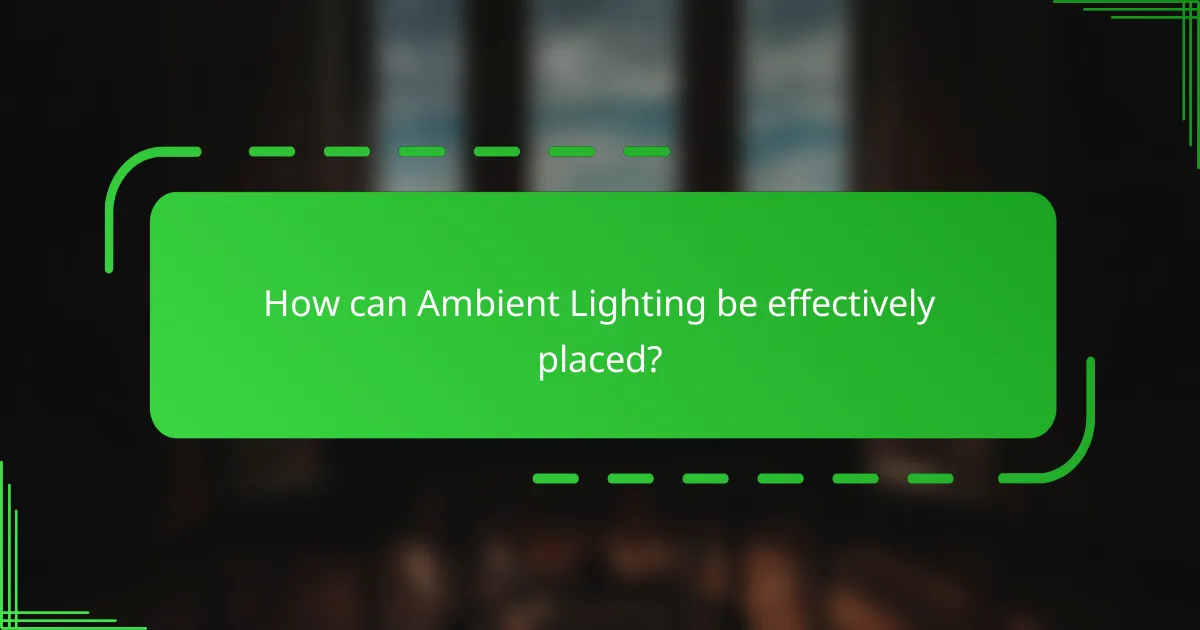Ambient lighting is the primary source of general illumination in a space, essential for enhancing visibility and comfort. This article explores the various types of ambient lighting, including ceiling fixtures, wall sconces, and floor lamps, and emphasizes the importance of proper placement strategies to achieve optimal light distribution. It discusses how effective ambient lighting can significantly improve room functionality and aesthetic appeal, while also reducing harsh shadows and glare. Additionally, the article highlights the psychological impact of ambient lighting on comfort and mood, supported by research findings.

What is Ambient Lighting?
Ambient lighting is the general illumination in a space. It provides a uniform light level that enhances visibility and comfort. This type of lighting is essential for creating a welcoming atmosphere. It can come from various sources, such as ceiling fixtures, wall sconces, or floor lamps. Ambient lighting helps reduce harsh shadows and glare. It is often the first layer of lighting considered in design. According to the American Lighting Association, effective ambient lighting improves overall room functionality. Proper ambient lighting contributes to the aesthetic appeal of a space.
How does Ambient Lighting differ from other types of lighting?
Ambient lighting provides overall illumination in a space, unlike task or accent lighting, which serve specific functions. It is designed to create a soft, even light that reduces harsh shadows. Ambient lighting is often achieved through ceiling fixtures, wall sconces, or natural light. This type of lighting enhances the mood and comfort of a room. In contrast, task lighting focuses on specific areas for activities like reading or cooking. Accent lighting highlights particular features or objects in a space. The primary difference lies in their purpose: ambient lighting sets the general atmosphere, while task and accent lighting serve functional or decorative roles.
What are the key characteristics of Ambient Lighting?
Ambient lighting is a type of general illumination that creates a soft, even light in a space. It is designed to provide a comfortable level of brightness without harsh shadows. This lighting is often diffused and can be achieved through various sources such as ceiling fixtures, wall sconces, or floor lamps. Ambient lighting enhances visibility while maintaining a cozy atmosphere. It serves as the foundational layer of lighting in a room. Ambient lighting can vary in intensity and color temperature to suit different moods. Its key characteristic is that it does not focus on specific areas, but rather illuminates the entire room uniformly. This type of lighting is essential for functional spaces while also contributing to the overall aesthetic.
Why is Ambient Lighting important in interior design?
Ambient lighting is important in interior design because it provides a foundational layer of illumination. This type of lighting enhances visibility and creates a comfortable atmosphere. It sets the mood for a space, influencing how people feel within it. Proper ambient lighting can make areas look larger and more inviting. It also highlights architectural features and decor elements. Studies show that well-designed ambient lighting can improve productivity and mood. For instance, a report by the Lighting Research Center indicates that appropriate lighting can reduce eye strain and increase comfort. Thus, ambient lighting is essential for both functionality and aesthetics in interior design.
What are the different types of Ambient Lighting?
There are several types of ambient lighting. The main types include ceiling-mounted fixtures, wall sconces, and recessed lighting. Ceiling-mounted fixtures provide broad illumination and are commonly used in living spaces. Wall sconces offer indirect light and enhance wall decor. Recessed lighting is installed into the ceiling for a clean look and can be used to highlight specific areas. Other types include floor lamps and table lamps, which add warmth and flexibility to a room’s lighting scheme. Each type serves to create a comfortable and inviting atmosphere in various settings.
What are the common sources of Ambient Lighting?
Common sources of ambient lighting include natural light, ceiling fixtures, wall sconces, and floor lamps. Natural light enters through windows and skylights, providing soft illumination during the day. Ceiling fixtures, such as chandeliers and flush mounts, distribute light evenly throughout a room. Wall sconces offer additional light while enhancing decor. Floor lamps can be placed in various locations to create warmth and comfort. Each source contributes to the overall atmosphere of a space, ensuring sufficient illumination for various activities.
How do different types of Ambient Lighting affect a space?
Different types of ambient lighting significantly affect a space’s mood and functionality. Soft, warm lighting creates a cozy atmosphere, ideal for relaxation. Bright, cool lighting enhances focus and productivity, making it suitable for workspaces. Dimmers allow for adjustable brightness, facilitating versatility in ambiance. Natural light improves well-being and promotes a connection to the outdoors. Layered lighting, combining ambient with task and accent lights, enhances depth and visual interest. Each type influences color perception, spatial awareness, and overall comfort in a room. Studies show that well-designed lighting can improve mood and productivity by up to 20%.

How can Ambient Lighting be effectively placed?
Ambient lighting can be effectively placed by considering the room’s layout and function. Install fixtures in areas where natural light is limited. Use ceiling-mounted lights for overall illumination. Incorporate wall sconces to create a soft glow. Position floor lamps in corners to enhance depth. Consider using dimmers to adjust brightness levels. Layer lighting by combining different sources for a balanced effect. Aim for uniform light distribution to avoid harsh shadows. These strategies enhance comfort and aesthetics in a space.
What placement strategies enhance Ambient Lighting?
Strategic placement of light fixtures enhances ambient lighting. Positioning lights at varying heights creates depth in a space. Wall sconces can provide soft illumination while avoiding glare. Floor lamps in corners can fill dark areas and create warmth. Using dimmers allows for adjustable brightness to suit different moods. Fixtures should be placed to avoid harsh shadows, promoting a balanced light distribution. Layering different light sources enhances overall ambiance. Finally, ensuring light fixtures are placed to highlight architectural features can add visual interest.
How does the height of light fixtures influence Ambient Lighting?
The height of light fixtures significantly influences ambient lighting by affecting light distribution and intensity. Higher fixtures typically provide broader light coverage, creating a more even illumination across a space. This can reduce harsh shadows and enhance the overall brightness of a room. Conversely, lower fixtures tend to concentrate light in a smaller area, which can create cozy, intimate spaces but may also lead to uneven lighting.
Research indicates that the optimal height for ambient lighting fixtures is generally between 7 to 9 feet from the floor. This height maximizes light spread while minimizing glare. Proper fixture height also allows for better interaction with other light sources, contributing to a balanced lighting scheme. Studies show that adjusting fixture height can change the perception of room size and shape, impacting the overall aesthetic experience.
What role do wall colors play in Ambient Lighting effectiveness?
Wall colors significantly influence the effectiveness of ambient lighting. Lighter wall colors reflect more light, enhancing brightness in a space. Darker colors absorb light, creating a cozier but dimmer atmosphere. The choice of color can alter the perceived size of a room. For example, soft pastels can make a room feel larger and more open. In contrast, bold, dark colors can create an intimate setting. Research shows that color temperature also affects mood and perception of light. Warm colors can make lighting feel softer and more inviting. Cool colors can create a more energetic and vibrant environment. Therefore, the role of wall colors is crucial in achieving the desired ambiance and functionality in a space.
What are the best practices for integrating Ambient Lighting?
The best practices for integrating ambient lighting include selecting the right fixtures, ensuring proper placement, and using dimmers. Choose fixtures that complement the room’s design and provide adequate light. Position lights to create even illumination without harsh shadows. Layer ambient lighting with task and accent lights for a balanced effect. Use dimmers to adjust brightness based on the time of day and activity. Incorporate natural light sources to enhance the overall lighting design. These practices improve functionality and aesthetics in any space.
How can Ambient Lighting be layered with other lighting types?
Ambient lighting can be layered with other lighting types to create a cohesive lighting design. Layering involves combining ambient lighting with task and accent lighting. Task lighting provides focused illumination for specific activities, such as reading or cooking. Accent lighting highlights architectural features or artwork, adding depth to the space.
For effective layering, consider the room’s function and desired mood. Use dimmable options for ambient lighting to adjust brightness levels. Place task lighting close to work areas for optimal visibility. Position accent lights to draw attention to focal points.
This approach enhances the overall aesthetic and functionality of the space. According to the American Lighting Association, layered lighting improves visual comfort and creates an inviting atmosphere.
What common mistakes should be avoided in Ambient Lighting placement?
Common mistakes in ambient lighting placement include inadequate ceiling height consideration. Low ceilings can create a cramped feel with overhead fixtures. Not accounting for room size is another error. Large rooms require more light sources for balanced illumination. Failing to layer lighting is also a mistake. Relying solely on ambient light can lead to uneven lighting. Additionally, neglecting the function of the space can result in poor lighting choices. For example, task areas need brighter lighting. Finally, overlooking the color temperature can affect ambiance. Warmer tones create a cozy feel, while cooler tones can feel sterile.

What aesthetic impacts does Ambient Lighting have?
Ambient lighting enhances the overall aesthetic of a space by creating a soft, diffused glow. This type of lighting improves visibility and sets the mood. It contributes to a warm and inviting atmosphere. Ambient lighting can highlight architectural features and artwork. It reduces harsh shadows and balances light distribution. Studies show that well-designed ambient lighting increases comfort and can influence emotions positively. For instance, a 2018 study published in the Journal of Environmental Psychology found that ambient lighting affects people’s perceptions of space and comfort levels.
How does Ambient Lighting influence mood and atmosphere?
Ambient lighting significantly influences mood and atmosphere by creating a specific ambiance in a space. It affects how individuals perceive their environment. Warm lighting tends to evoke feelings of comfort and relaxation. Conversely, cooler lighting can enhance alertness and focus. Studies show that lighting color temperature impacts emotional responses. For example, a study published in the Journal of Environmental Psychology found that warm light promotes positive emotions. In contrast, harsh lighting can lead to feelings of stress or discomfort. Therefore, the choice of ambient lighting plays a crucial role in shaping emotional experiences in various settings.
What psychological effects can Ambient Lighting create?
Ambient lighting can create various psychological effects. It influences mood and emotional well-being. For instance, warm lighting can evoke feelings of comfort and relaxation. In contrast, cooler lighting may stimulate alertness and productivity. Research indicates that lighting color temperature affects cognitive performance. Studies show that dim lighting can promote a sense of intimacy and calmness. Bright ambient lighting can enhance focus and energize a space. The overall atmosphere created by ambient lighting impacts social interactions and perceptions of space. Therefore, careful consideration of ambient lighting is essential for desired psychological outcomes.
How can Ambient Lighting enhance architectural features?
Ambient lighting enhances architectural features by providing a soft, uniform illumination that highlights design elements. This type of lighting creates a welcoming atmosphere in spaces. It emphasizes textures and colors in materials used in architecture. For example, ambient lighting can accentuate wood grain or stone surfaces. Proper placement of ambient lighting can also create visual depth in a room. It allows architectural lines and shapes to stand out without harsh shadows. Studies show that well-implemented ambient lighting can improve the perception of space. This contributes to overall aesthetic appeal and functionality in design.
What are the trends in Ambient Lighting design?
Trends in ambient lighting design focus on energy efficiency, smart technology integration, and customizable solutions. Energy-efficient LED lighting continues to dominate the market. Smart lighting systems allow users to control brightness and color remotely. Customizable ambient lighting enhances personal expression in spaces. Layered lighting techniques create depth and warmth in interiors. Biophilic design is gaining traction, incorporating natural elements into lighting. Minimalist designs emphasize simplicity and functionality. Sustainable materials are increasingly used in light fixtures to promote eco-friendliness.
How is technology changing the landscape of Ambient Lighting?
Technology is significantly transforming the landscape of ambient lighting. Innovations such as smart lighting systems allow users to control brightness and color via apps. These systems often integrate with home automation for enhanced convenience. LED technology has made ambient lighting more energy-efficient and versatile. Dimming capabilities and color temperature adjustments are now standard features. Additionally, advancements in sensor technology enable automatic adjustments based on occupancy and natural light levels. Data from the U.S. Department of Energy indicates that LED lighting consumes up to 75% less energy than traditional incandescent bulbs. This shift towards smart and efficient lighting solutions is reshaping how spaces are illuminated and experienced.
What are the emerging styles in Ambient Lighting?
Emerging styles in ambient lighting include biophilic design, minimalist aesthetics, and smart lighting solutions. Biophilic design integrates natural elements, promoting well-being and connection to nature. This style often uses organic shapes and materials. Minimalist aesthetics focus on simplicity and functionality, utilizing clean lines and subtle illumination. Smart lighting solutions incorporate technology for customizable settings and energy efficiency. These styles reflect current trends in sustainability and personal expression in interior design.
What practical tips can enhance Ambient Lighting in your space?
Use layered lighting to enhance ambient light in your space. This involves combining different light sources such as overhead fixtures, floor lamps, and table lamps. Choose warm-colored bulbs to create a cozy atmosphere. Dimmer switches allow for adjustable brightness, enhancing flexibility in lighting. Incorporate reflective surfaces like mirrors to amplify light distribution. Use wall sconces to provide indirect lighting, adding depth to the room. Place lights strategically to highlight architectural features or artwork. Finally, consider smart lighting solutions for customizable ambiance. These tips collectively contribute to a well-lit, inviting environment.
How can you choose the right fixtures for effective Ambient Lighting?
To choose the right fixtures for effective ambient lighting, consider the room’s purpose and size. Fixtures should provide a soft, even light that covers the entire area. Select fixtures with adjustable brightness for flexibility. Consider the color temperature of the bulbs; warm white (2700K-3000K) is ideal for a cozy atmosphere. Ensure the fixtures complement the room’s decor style. Use dimmers to control light intensity and enhance mood. Finally, opt for energy-efficient options like LED fixtures to reduce energy consumption. These choices lead to a well-lit, inviting environment.
What maintenance practices ensure optimal performance of Ambient Lighting?
Regular cleaning of ambient lighting fixtures ensures optimal performance. Dust and grime can diminish light output. Use a soft cloth or duster to wipe surfaces. Check for loose bulbs or connections periodically. Replace burnt-out bulbs promptly to maintain consistent illumination. Ensure that dimmer switches are functioning properly. Adjust settings to prevent overheating of fixtures. Regularly assess the placement of fixtures for maximum light distribution. These practices enhance the longevity and effectiveness of ambient lighting.
Ambient lighting is the general illumination in a space, crucial for creating a welcoming atmosphere and enhancing visibility. This article explores the various types of ambient lighting, including ceiling fixtures, wall sconces, and natural light, while highlighting their unique characteristics and placement strategies. It also examines the aesthetic impact of ambient lighting on mood and functionality in interior design, discussing best practices for integration and common mistakes to avoid. Additionally, the article addresses emerging trends and technological advancements shaping the future of ambient lighting design.
